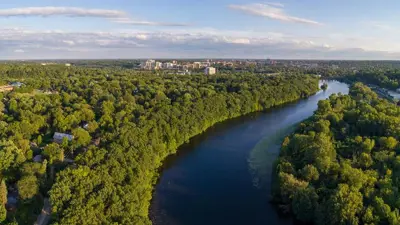Building in the floodplain can have serious consequences, including:
- Increase in overall flooded area: Buildings and other structures in the floodplain displace flood waters, pushing overflow further out into the watershed and affecting lands and buildings that would not be at risk otherwise.
- Greater financial losses through property damage when flooding occurs.
- Increase in risks to human safety: Deaths and injuries from drowning, being trapped in vulnerable structures, or being struck by flood debris all increase once floodplains are developed.
Regulations for Building in the Floodplain
Flooding is a natural process. Reducing property damage and protecting human safety when flooding does occur are two goals of floodplain management. There are many policies and regulations in place regarding the protection and management of floodplains.
The State, County, and City all have regulations pertaining to floodplains and floodplain development. Some of these regulations are required for participants in the National Flood Insurance Program (NFIP) and are legally enforced under the Michigan Building Code.
General Criteria for floodplain development
- All development in the City require permits from Planning and Development Services.
- Construction within an easement (typically a 30-foot on either side of the centerline of all above ground and underground creeks) that falls within County jurisdiction requires a permit from the Washtenaw County Water Resources Commissioner.
- Construction within the floodplain requires a permit from the Michigan Department of Natural Resources and Environment (MDNRE). Flood flow may not be obstructed in a manner that causes a rise in flood elevations at the property line.
- State, County, and City all require no net loss of flood storage capacity; i.e., no fill without compensatory dredging.
Standards for development in the floodway
- The NFIP recommends that all development in the floodway be discouraged.
- The State prohibits residential uses in the floodway in areas under the jurisdiction of the MDNRE.
- For all development in the floodway, the developer must submit an engineering study certifying that the development will not raise the base flood elevation (BFE).
- The lowest floor of any new non-residential structure must be elevated or flood-proofed to an elevation 1 foot above the 100-year flood elevation.
- The NFIP recommends that residential uses in the floodplain be discouraged.
- The lowest floor of any new residential structure must be elevated to an elevation 1 foot above the 100-year flood elevation.
- The lowest floor of any new non-residential structure must be elevated or flood-proofed to an elevation 1 foot above the 100-year flood elevation.
- All structures that are improved in the floodplain and floodway must meet standards for new buildings if the value of the improvements exceeds 50% of the market value of the structure.
- Note: historic structures are exempt from the substantial improvement requirement, provided that the historic character of the structure is maintained.
The City of Ann Arbor committed to enforcing these flood resistance construction standards by adoption of a floodplain resolution (PDF) on March 5, 2012. The resolution was required for the City's continued participation in the NFIP.
Fencing in the floodplain
Please use Ann Arbor's Floodplain Fencing Requirements guidance document (PDF) for guidance.

